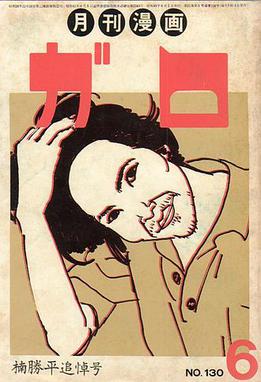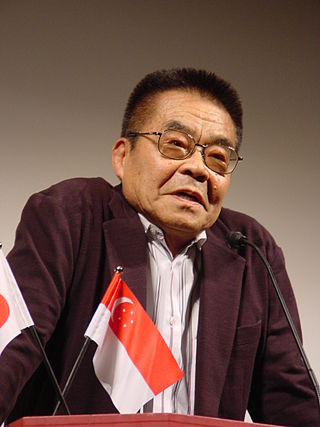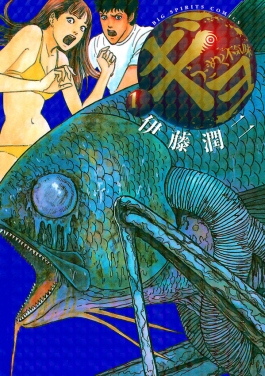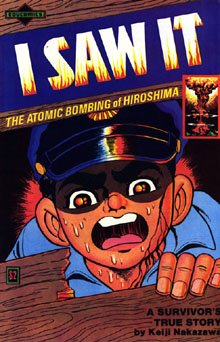Gekiga is a style of Japanese comics aimed at adult audiences and marked by a more cinematic art style and more mature themes. Gekiga was the predominant style of adult comics in Japan in the 1960s and 1970s. It is aesthetically defined by sharp angles,dark hatching,and gritty lines,and thematically by realism,social engagement,maturity,and masculinity.

Akira is a Japanese cyberpunk post-apocalyptic manga series written and illustrated by Katsuhiro Otomo. It was serialized biweekly in Kodansha's seinen manga magazine Young Magazine from December 20,1982,to June 25,1990,with its 120 chapters collected into six tankōbon volumes. It was initially published in the United States by Marvel Comics under its Epic imprint,becoming one of the first manga works to be translated in its entirety into English. It is currently published by Kodansha Comics in North America. Considered a watershed title for the medium,the manga is also famous for spawning the seminal 1988 cyberpunk anime film adaptation of the same name and the greater franchise.
An autobiographical comic is an autobiography in the form of comic books or comic strips. The form first became popular in the underground comix movement and has since become more widespread. It is currently most popular in Canadian,American and French comics;all artists listed below are from the U.S. unless otherwise specified.
Keiji Nakazawa was a Japanese manga artist and writer.

Drawn &Quarterly (D+Q) is a publishing company based in Montreal,Quebec,Canada,specializing in comics. It publishes primarily comic books,graphic novels and comic strip collections. The books it publishes are noted for their artistic content,as well as the quality of printing and design. The name of the company is a pun on "drawing","quarterly",and the practice of hanging,drawing and quartering. Initially it specialized in underground and alternative comics,but has since expanded into classic reprints and translations of foreign works. Drawn &Quarterly was the company's flagship quarterly anthology during the 1990s.

Adrian Tomine is an American cartoonist. He is best known for his ongoing comic book series Optic Nerve and his illustrations in The New Yorker.

Garo (ガロ) was a monthly manga anthology magazine in Japan,founded by Katsuichi Nagai and published by Seirindōfrom 1964 until 2002. It was fundamental for the emergence and development of alternative and avant-garde manga.
Alternative manga or underground manga is a Western term for Japanese comics that are published outside the more commercial manga market,or which have different art styles,themes,and narratives to those found in the more popular manga magazines. The term was taken from the similar alternative comics. The artistic center of alternative manga production was from the 1960s until the 1990s the manga magazine Garo,which is why in Japan,alternative manga are often called Garo-kei,even if they were not published in Garo.

Yoshihiro Tatsumi was a Japanese manga artist whose work was first published in his teens,and continued through the rest of his life. He is widely credited with starting the gekiga style of alternative manga in Japan,having allegedly coined the term in 1957. His work frequently illustrated the darker elements of life.

Gyo,fully titled Gyo Ugomeku Bukimi in Japan,is a horror seinen manga written and illustrated by Junji Ito,appearing as a serial in the weekly manga magazine Big Comic Spirits from 2001 to 2002. Shogakukan collected the chapters into two bound volumes from February to May 2002. The story revolves around a couple,Tadashi and Kaori,as they fight to survive against a mysterious horde of undead fish with metal legs powered by an odor known as the "death stench". The work also includes a pair of bonus stories,titled The Sad Tale of the Principal Post and The Enigma of Amigara Fault.

Town of Evening Calm,Country of Cherry Blossoms is a one-volume manga written and illustrated by Fumiyo Kōno. The two connected stories were first published in Japan by Futabasha in Weekly Manga Action in 2003 and 2004,then collected in a single tankōbon volume in 2004. The story is about a family of survivors of the atomic bombing of Hiroshima. The author based the characters on people who were in Hiroshima or Nagasaki.

Nono-chan (ののちゃん) is a yonkoma manga series begun in 1991 by Hisaichi Ishii originally serialized as My Neighbors the Yamadas in the Asahi Shimbun in Japan. When the series first began,it was generally focused on all of the members of the Yamada family. As the series progressed,the daughter became the most popular character among readers and more of the strips focused on her and her point of view. In 1997,the series title was changed to reflect this change of focus. The Asahi Shimbun continues to feature this manga series as of October 2007.

I Saw It:The Atomic Bombing of Hiroshima:A Survivor's True Story,titled Ore wa Mita (おれは見た) in Japanese,is a one-shot manga by Keiji Nakazawa that first appeared in 1972 as a 48-page feature in the magazine Monthly Shōnen Jump. The story was later published in a collection of Nakazawa's short stories by Holp Shuppan. I Saw It is an autobiographical piece following the life of Nakazawa from his youngest days in post-war Hiroshima,up until his adulthood. I Saw It became the predecessor for Nakazawa's popular manga series Barefoot Gen.

A Drifting Life is a Japanese manga series written and illustrated by Yoshihiro Tatsumi that chronicles his life from 1945 to 1960,the early stages of his career as a manga artist. It earned Tatsumi the Tezuka Osamu Cultural Prize and won two Eisner Awards.

Tatsumi is a 2011 Japanese-language Singaporean animated drama film directed by Eric Khoo. It is based on the manga memoir A Drifting Life and five earlier short stories by the Japanese manga artist Yoshihiro Tatsumi. The film is a Singaporean production with Japanese dialogue,and was animated in Indonesia.

Abandon the Old in Tokyo is a collection of gekiga short stories by manga artist Yoshihiro Tatsumi. It collects eight stories by Tatsumi from 1970,which were serialized in various manga magazines including Weekly Shōnen Magazine and Garo,and was published by Drawn &Quarterly on August 1,2006. The manga won the 2007 Harvey Award for Best U.S. Edition of Foreign Material,sharing it with the first volume of Tove Jansson's Moomin. It was also nominated for the 2007 Eisner Award for Best Archival Collection/Project –Comic Books.

The Push Man and Other Stories is a collection of gekiga short stories by manga artist Yoshihiro Tatsumi. It collects sixteen stories by Tatsumi which were serialized in the manga magazine Gekiga Young as well as in self-published dōjinshi magazines in 1969. Drawn &Quarterly collected the stories and published them on September 1,2005. In 2006,the manga was nominated for the Ignatz Award for Outstanding Anthology or Collection and the Harvey Award for Best American Edition of Foreign Material.

Black Blizzard is a Japanese manga written and illustrated by Yoshihiro Tatsumi and published by Hinomaru Bunko in November 1956. It is about two convicts who are handcuffed together and escape after the train they are being escorted on crashes. Written by Tatsumi in twenty days,it is considered to be one of the first full-length gekiga works.

Fallen Words is a collection of rakugo short stories by manga artist Yoshihiro Tatsumi. The manga was published on July 3,2009,by Basilico,with Drawn &Quarterly publishing it in North America on May 8,2012.
Masahiko Matsumoto was a Japanese manga artist. He is considered a pioneer of alternative manga through his incorporation of cinematic techniques into manga from the mid-1950s onward. His style known as komaga,together with the manga of Yoshihiro Tatsumi and Takao Saito,was the catalyst of the gekiga movement.















